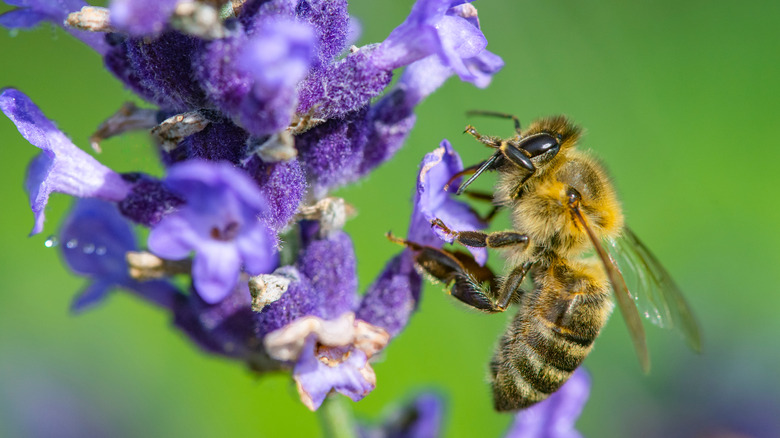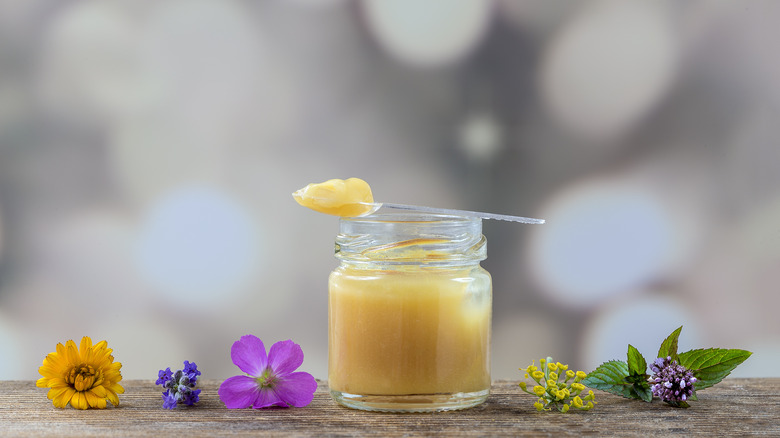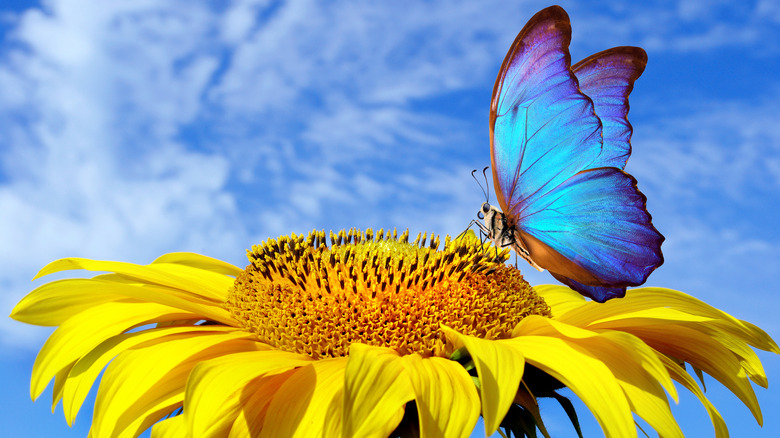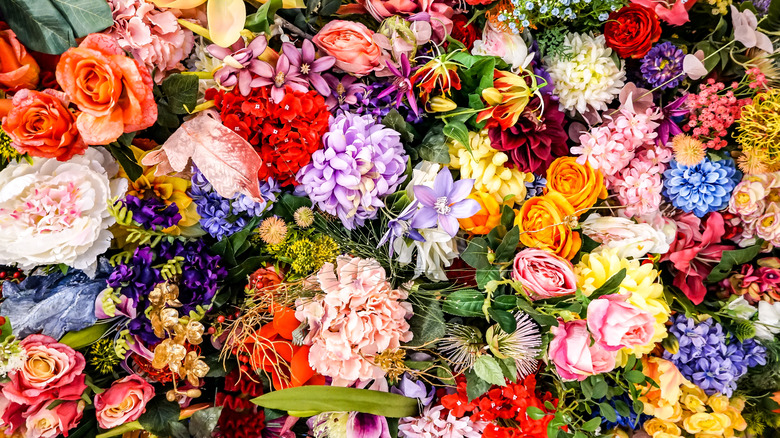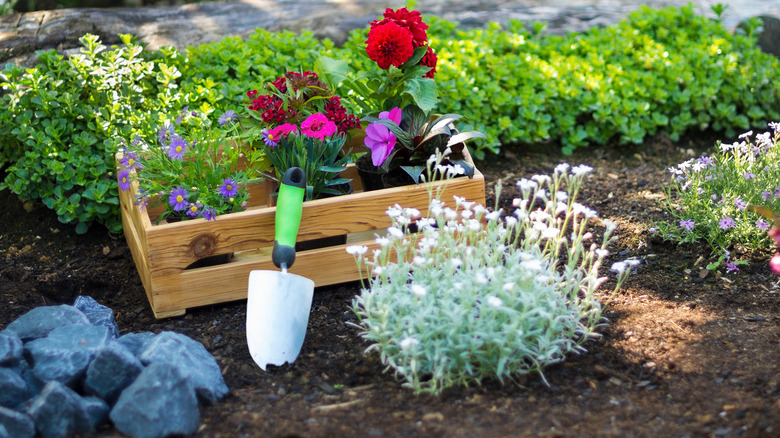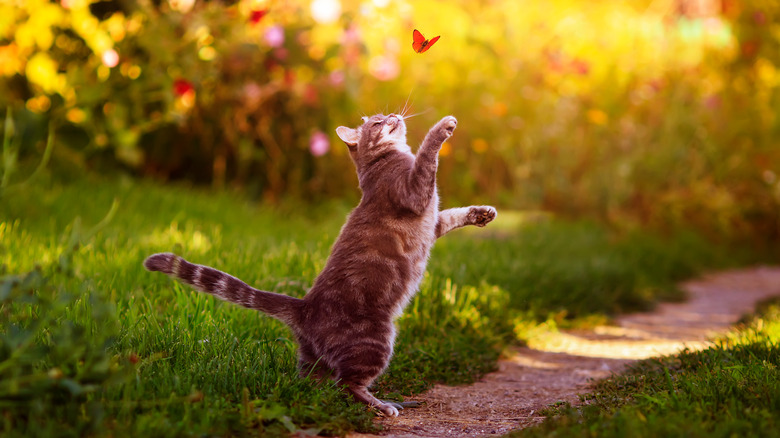How To Start A Pollinator Garden
Birds, bees, and butterflies have been moving pollen from plant to plant for millions of years, says Science Daily. However, today's manicured landscapes and pesticides that we thought were safe are putting all of that in jeopardy. While pollinating insects are doing their part, we can do ours by growing them a lovely pollinator garden.
A pollinator garden assembles nectar and pollen-rich plants so insects can more easily do the yeoman's labor that has become a backbone of our ecosystem and global food supply. More than 80% of modern plants around the world depend on pollination, which helps maintain the diversity and health of wildflowers, shrubs, and trees, says the U.S. Forest Service. However, the necessity of pollination goes way beyond foliage variety and pretty meadows. Daily nutritional basics, from the fruit we love, like apples, oranges, peaches, and pears, to nuts like almonds, to morning pick-me-ups like coffee, depend on pollination. Keep reading for tips on how to start your own pollinator garden.
Why plant a pollinator garden?
Pollinator gardens are one way to interrupt a terrible ecological trend where our bees and butterfly populations are disappearing, says the National Wildlife Federation. Declining populations of insects that pollinate our flowers is bad news for our plants which means bad news for our global food supply. According to the BBC, honey bees, some of our biggest pollinating heavyweights, are responsible for pollinating more than three-fourths of the crops that feed 90% of the world.
Pollinator gardens may be the new trend du jour among gardening aficionados, but they represent an old idea -– that we can affect global change and have political impact starting quite literally from our own backyard, says Eco Landscape Alliance. Even a small pollinator garden, planter, or pot can make a big difference, particularly if it repopulates otherwise under-vegetated urban spots with blooms that offer a nectar and pollen supply from spring through the fall, says Gardening etc. Plus, a good pollinator garden offers more than nectar. It reprioritizes the function of a garden over its manicured presentation, which means that other than minimal weeding, according to The Spruce, you are making a massive contribution to our ecosystem for relatively minimal effort.
What to consider before planting a pollinator garden
As you give initial thought to your pollinator garden, consider the fact that not all plants marketed as pollinator-friendly actually are, especially if they are not regional plants that are native to your area, according to Gardenista. Planting non-native plants in a pollinator garden causes problems for pollinators. One example is the lupine plant. Certain butterflies forage off of a wild lupine plant, Lupinus perennis, but what is more commonly planted is the L. polyphyllus. Because gardeners are well intended but not necessarily well informed, the frosted elfin butterflies that count on Lupinus perennis, the wild lupine, are now endangered. To avoid this kind of non-native planting in your pollinator garden, ask local plant providers about regional pollinator plants, or check with the North American Native Plant Society.
Once you know which pollinating plants are smart regional choices, start thinking about blooming seasons. You will want blooms that sprout and develop at varying times throughout the year and that attract a variety of pollinating insects, says Love Your Landscape. Pollinators care about nectar and seeds, but they find their way to them by color and shape — hummingbirds like reds, fuchsia, and purple. Bees, on the other hand, like white and yellow and love a flat flower-landing pad such as the Shasta daisies. However, be sure to avoid the thick, double-layer petals variety that impedes nectar access, says Savvy Gardening.
How to choose the flowers for a pollinator garden
Offering a variety of colors, food, fragrance, and shelter in your pollinator garden is best, but pollinators still have their favorites. According to Monrovia, here are some examples of flowers that hummingbirds, bees, and butterflies love.
Coneflower (Echinacea) have long bloom stretches, and bees seem to love them no matter the size or color. Stonecrop (Sedum) includes pretty pollinating flowers and simpler ground cover varieties that offer beauty and hardiness. Milkweeds (Asclepias) are popular with caterpillars while they feast their way into becoming monarch butterflies. Butterflies and bees also like this plant's nectar. Sunflowers (Helianthus) are like sunshine in the garden with their big yellow blooms and great nectar for bees and honeybees. Lavender (Lavandula) is easy in gardens or pots and is a gift to pollinators and gardeners for their unrivaled aromatic scents. Goldenrod (Solidago) is an enduring food source since their blooms persevere through fall.
No matter what flowers you decide for your pollinator garden, remember that native plants are best. Also, if space allows, consider flowering trees and shrubs like the American beautyberry, lacecap hydrangea, and fragrant tea olive, which offer valuable nectar and pollen, says the University of Georgia. If yours is a little but mighty urban garden, remember to include late-blooming plants like dahlias, says Gardening etc, since bees will love their open flower and food supply.
How to care for a pollinator garden
Remember that a pollinator garden packs a punch no matter how big or small. However, if you are planning an expansive garden, consider tilling your current soil first and then adding a few inches of compost to the area, says Gardenista. You will want to map out your garden with a variety of native flowers, and it is nice if they bloom in shifts throughout the year. Plant tall plants toward the middle of your garden and consider which blooms would make good clusters. Add plants that offer shelter, such as grasses, if your garden has room. After thoroughly watering your freshly planted pollinator garden, consider a final layer of mulch, but do not pack it right up tight to the plants.
Over the life of your pollinator garden, resist the temptation to pull out fading flowers as their blooming seasons close, says Farm and Dairy. Those brown leaves and wilted stems can become a lifeline to pollinators throughout the winter months. For example, several varieties of butterflies hibernate under the rubbish of dead flowers and leaves once the weather gets cold. Additionally, refrain from walking through your pollinator garden unless absolutely necessary, says Xerces Society. Bees regularly nest in the ground and other insects, like woolly bear caterpillars, are likely settling in under the shelter of your pollinator garden debris.
Anyone can grow a pollinator garden
If you wish you could plant a pollinator garden but feel like you come up short in important ways like budget and space, and know-how, think again. Simple, small solutions still make a big difference. Try a few pots on an apartment balcony where you can plant even two or three flowers that produce nectar or pollen-laden blooms from spring through fall, says Better Homes & Gardens.
Containers with small shrubs are another idea to keep in mind since they uniquely rescue pollinators through the winter months. Plants or small trees you may not have considered feasible to grow in pots can actually thrive in a container for years, like the witch hazel shrub, says Garden Design. That is great news for some insects, like those moth varieties that stay active through the winter months by hiding during the day and feeding on woody shrub nectar at night, according to Coastal Rivers Conservation Trust.
Essentially, anyone can grow a pollinator garden. Just find a sunny spot, steer clear of using any pesticides, and go for flowers that are colorful, native, and bloom in shifts throughout the season, says The Spruce. The bees and butterflies will thank you.
